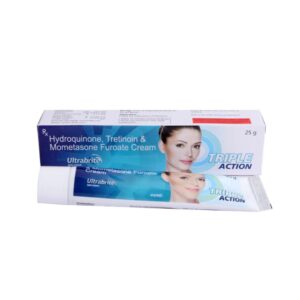MOMETASONE + HYDROQUINONE
Mometasone: Mometasone is a corticosteroid medication that is primarily used to treat inflammatory skin conditions such as eczema and psoriasis. It is available as a cream, ointment, lotion, or inhaler.
The mechanism of action of mometasone involves inhibiting the release of inflammatory substances in the body, thereby reducing inflammation and relieving symptoms. It works by binding to glucocorticoid receptors, which results in the suppression of the immune response and the prevention of the release of inflammatory mediators.
The dose and duration of mometasone treatment depend on the specific condition being treated and the severity of symptoms. It is important to follow the instructions provided by the healthcare professional or as indicated on the medication label. Typically, mometasone cream or ointment is applied to the affected area of the skin once or twice daily. The lotion form may be applied to larger areas of the body. The inhaler form is used for the treatment of asthma and should be inhaled as directed by the healthcare professional.
As with any medication, mometasone can have side effects, although not everyone may experience them. Common side effects may include skin irritation, itching, redness, burning, or dryness at the site of application. These side effects are usually mild and tend to improve as the body adjusts to the medication. In rare cases, mometasone can cause more serious side effects such as thinning of the skin, changes in skin pigmentation, skin infections, or allergic reactions. Long-term use of mometasone on large areas of the body or under occlusion may increase the risk of systemic absorption and the potential for side effects.
It is important to consult a healthcare professional for proper guidance on the use of mometasone, especially for long-term or high-dose treatment. They can assess the benefits versus the risks and provide recommendations for safe and effective use.
Hydroquinone: Hydroquinone is a topical medication primarily used for skin lightening and treating dark spots, melasma, hyperpigmentation, and other skin discoloration conditions. It is available over-the-counter in low concentrations and as a prescription-strength medication in higher concentrations.
The mechanism of action of hydroquinone involves inhibiting the activity of an enzyme called tyrosinase, which is essential for the production of melanin, the pigment responsible for skin color. By reducing melanin production, hydroquinone helps to lighten the skin and fade dark spots.
The usual recommended dose of hydroquinone is to apply a thin layer of the cream or gel to the affected areas of the skin twice a day. It is important to follow the instructions provided by your healthcare provider or the product packaging. Treatment duration may vary, and it typically takes several weeks to see noticeable results.
While hydroquinone is generally considered safe for short-term use, it may cause some side effects. Common side effects include mild skin irritation, redness, dryness, and a mild burning or stinging sensation. These side effects are usually temporary and subside with continued use. However, if severe skin irritation or an allergic reaction occurs, it is important to discontinue use and seek medical attention.
Prolonged use of high-concentration hydroquinone products (above 2%) may lead to adverse effects such as skin darkening (exogenous ochronosis) or a bluish-black discoloration of the skin. Therefore, it is essential to use hydroquinone as directed, for the recommended duration, and avoid excessive or prolonged use.
In some countries, hydroquinone may be banned or restricted due to potential safety concerns. It is always advisable to consult with a healthcare professional before starting any new medication or treatment, including hydroquinone, to ensure its suitability for your specific needs.

